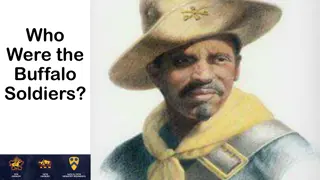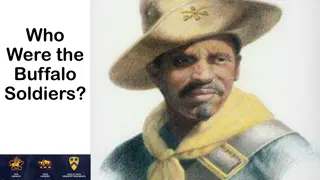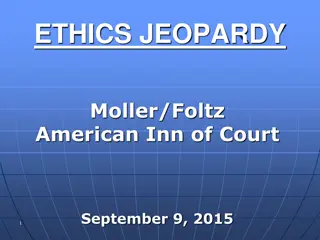Weapons and Soldiers in the Battle of Guilford Courthouse
Discover the weapons used by American soldiers in the Battle of Guilford Courthouse during the American Revolution, such as black powder, artillery, muskets, and rifles. Learn about the challenges faced on the battlefield and the roles of militiamen in state-raised armies. Explore the strategies and equipment that shaped this historic conflict through detailed descriptions and primary source excerpts.
Download Presentation

Please find below an Image/Link to download the presentation.
The content on the website is provided AS IS for your information and personal use only. It may not be sold, licensed, or shared on other websites without obtaining consent from the author.If you encounter any issues during the download, it is possible that the publisher has removed the file from their server.
You are allowed to download the files provided on this website for personal or commercial use, subject to the condition that they are used lawfully. All files are the property of their respective owners.
The content on the website is provided AS IS for your information and personal use only. It may not be sold, licensed, or shared on other websites without obtaining consent from the author.
E N D
Presentation Transcript
Guilford Courthouse National Military Park American Soldiers of the Battle of Guilford Courthouse Travel Trunk Lesson Plan This project was made possible by a grant from the National Park Foundation through generous support of partners like Disney, the lead sponsor of Open Outdoors for Kids, and donors across the country.
Black powder - Explosive charge used as gunpowder during the American Revolution. When fired, the powder would make large clouds of smoke and cover the battlefield, making it difficult to see. All 18th century guns used black powder. Artillery - Artillery soldiers fired cannonballs or grapeshot of different weights from cannons at long distances to hit large numbers of the enemy. The British and American armies at the Battle of Guilford Courthouse used 3-pounder and 6-pounder cannons.
Musket - The most important weapon in the American Revolution. Most soldiers used this type of gun. The musket has a smooth bore, which means the ball ricochets in the barrel. It was hard to pick a target at further than 60 yards. In the American Revolution, an army fought in groups of men at a close range, and when a group of muskets fired, a wall of lead hit the enemy. Rifle - This type of gun was not as commonly used as a musket. The inside of a rifle has grooves that spin the bullet. This meant the soldier can pick a target, unlike with a musket. However, the rifle took longer to load, which was not effective on a battlefield.
[Nathanael Greene] To Colonel Henry Lee, Jr. Camp at High Rock Ford [N.C.] March 9, 1781 9oClock PM I am vexed to my soul with the Militia, they desert us by hundreds nay by thousands. I am now waiting for General Caswell and the Continental troops to join us; which will not take place until tomorrow Night, nor can we organnise the Army sooner. After which we shall march in pursuit of the enemy as soon as possible, tho our force will not be very respectable
Militiaman - A farmer or tradesman (like a blacksmith) who joined a state- raised army for three months to fight in the American Revolution. The age requirement for enlistment was 16 60 years old. The state governor or commanding general called regiments of a militia up for service. Hunting Frock A field garment worn by men in the colonial era for hunting. Worn by militia units because this was everyday clothing a man would have and he would wear this while serving a three- month service.
Musket - The most important weapon in the American Revolution. Most soldiers used this type of gun. The musket has a smooth bore, which means the ball ricochets in the barrel. It was hard to pick a target at further than 60 yards. In the American Revolution, an army fought in groups of men at a close range, and when a group of muskets fired, a wall of lead hit the enemy. Bayonet this was not a common weapon for a militiaman. A bayonet (bay o net) is a sharp weapon on the end of a musket, used for stabbing, commonly used by professional soldiers. These soldiers are wearing a hunting frock like a militiaman, but they are actually Continental Soldiers before George Washington created a uniform.
Continental Soldier A professional soldier who serves for more than three years in the United States Army under General George Washington, or Major General Nathanael Greene. In the last phase of the war, General Washington split the Continental Army between the North and the South. Nathanael Greene led the Southern Campaign of the American Revolution. Note how the two Continental soldiers on the left are holding muskets and bayonets
Uniform - A standard outfit for soldiers. In 1779 George Washington no longer used hunting frocks for the US Army, instead each region had an official uniform modeled after the British uniform, but with opposite colors. This Continental Soldier is from Delaware. This region of the country has red facings on a blue coat.
In the travel trunk are three accoutrements (soldiers equipment) read the following definition and use the clues to match the item to the vocabulary term! Cartridge Box a soldier stored his black powder ammunition in a leather pouch to keep it dry. Haversack - A linen bag used by a soldier to carry his food rations and eating utensils. Canteen Made of wood or tin, used by a soldier to carry water.























